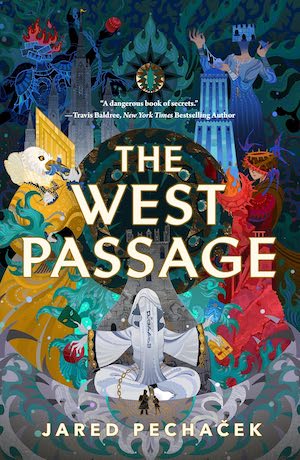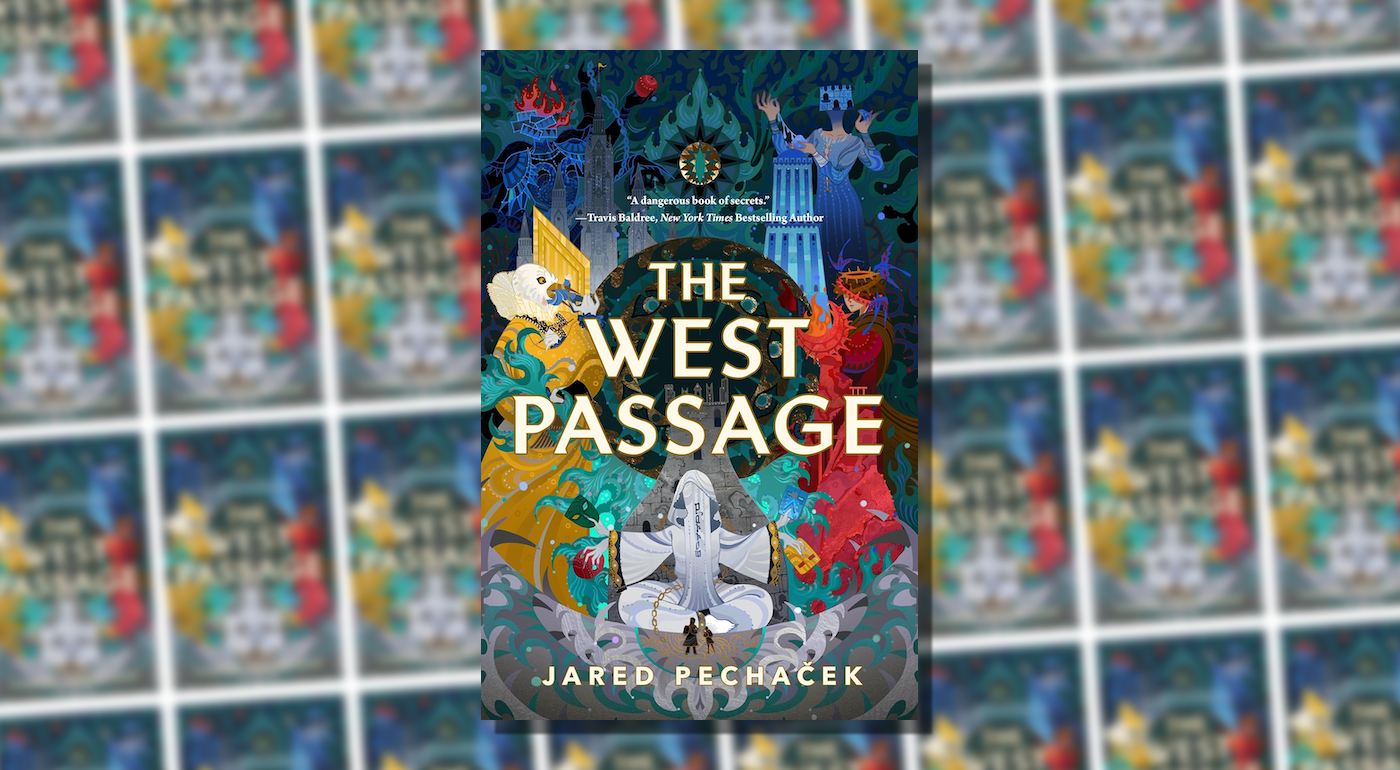There is something comforting in watching a couple of little guys making good in a bigger world, and following in this tradition, Jared Pechaček’s debut novel The West Passage delivers a warm, lovingly-crafted adventure built on the narrative bones of fairy tales, classic bildungsroman, and surrealist fantasy. The most obvious blueprint for the former would be hobbits being gently but firmly booted out of the Shire to save the world; it is, for better or worse, the best known example of its kind in fantasy and arguably broader popular literature. It makes perfect sense, then, that Pechaček is a Tolkien enthusiast, and has clearly studied the blade when it comes to the minutiae of hierarchical, ritualistic life from past ages. But The West Passage is very much its own well-formed creature, shepherded into being by a bright, confident hand to stand on its own two feet (or even three, in the world of palace anatomy).
The West Passage is told primarily through the journeys of Pell and Kew, two teen apprentices from Grey Tower—the central node of a vast, rambling palace complex, that, for its inhabitants, may as well be the whole world. Pell belongs to Grey House, an order of women charged with the rituals of life and death, while Kew was most recently the apprentice to the Guardian of the West Passage, who dies just before the book begins. While Pell and Kew—both of whom have been groomed to inhabit very specific roles in their respective institutions—are the dual heart of the story, what I loved was how well Pechaček chose to expand these core narratives into a larger ensemble story, dipping a strategic toe into the different waters of each palace tower without losing focus on the two protagonists’ development.
Pechaček is meticulous in his attention to detail, painting complete pictures of these Grey-led caretaking scenes with generous attention to scent and texture and sound. It’s easy to see that this is a place of tradition, held together with obedience and hierarchy in the familiar way that foreshadows an inevitable upheaval; small little things, almost inconsequential, begin to snowball slowly, steadily, into the shape of a serious omen. But while Grey Tower is an ancient, crumbling core that takes its load-bearing duties very seriously, it’s balanced out nicely by smart, understated levity. In tandem with bleak, remorselessly matter-of-fact moments of despair, Pechaček’s use of lightness—dramatic indulgences, fleeting glints of droll pettiness, relatable wryness in the strangest places, the dry humor in his chapter names—elevates the palace world into something far beyond the average “ sheltered kids make good” adventure.
Buy the Book

The West Passage
People aside, the most compelling character for such a setting-centric story like this is, of course, the palace itself—five fragmented towers, Grey, Black, Red, Blue, and Yellow—which sits in an unknown place in an unknown world. Pell and Kew each venture out (quite independently of the other) into a landscape that neither knows much about beyond hearsay and books; Pell, who stands to inherit the responsibility of running Grey Tower, has never really needed to think beyond her order’s cloisters, while Kew, whose life has revolved mostly around elder knowledge and books, has no material experience with the world he was trained to defend. But rather than having these sheltered souls traverse across a static landscape, Pechaček reminds us in every scene that this pseudo-sentient palace is both a living, breathing horror, as well as a Kafkaesque layer cake of senseless bureaucracy (truly, at times, the same thing).
The Ladies, for instance, are inextricable parts of this palace landscape—the terrifying rulers of each tower, with Black Tower and its ruling Lady serving as the first among equals (though it becomes clear that the Ladies are very much not on the same footing). Each is a unique, unknowable universe marked by their own peculiar surreal motifs; the lasting impressions I had of each Lady were the overwhelming architectural qualities of their presence and presentation. Not only are they enormous—Pechaček’s approach to characterization has fun playing with scale and geometry—they are distinctly structural, stylized beings made of (and this is an important distinction, as opposed to being clothed in) specific materials, embellished to the hilt like sinister, sociopathic skyscrapers. The result is an unholy marriage of what stems from (clearly) Pechaček’s great love of formal costuming, architecture, and baroque aesthetics, and it works extremely well.
In some ways, the Ladies reminded me of the witches from Puella Magi Madoka Magica—inscrutable, fantastical, unreachable, and inevitable parts of the world they live in. What Pechaček did with each Lady was to cultivate a tangible sense that our protagonists were up against a concept or a feeling or at times, a fucking mountain, rather than a cogent entity capable of negotiation and logic, which makes perfect sense when you consider the Madoka Magica witches as the personification of bad vibes. But it’s also the chimeric nature of the witches—in the case of Ladies, what I felt was a technicolor patchwork of competing wills—which brought me to this comparison. The Ladies are, if anything, monstrously constructed spectacles that are inextricable from the land and towers that they dominate; there is a profound sense that to confront them is to confront the quiet, rotten truth at the core of one’s reality.
The West Passage, at least for me, was a lovely return to a genre I haven’t visited in some time, the fairy tale, though this one has more modern sensibilities focused on broader structural social commentary than folklore-centric fairy tales that tended to speak to issues around morality and related social phenomena (historically often things like child abandonment, poverty, changing family structures, and so on). Most of all, though, it reminded me of forgotten gems from the past (albeit ones that were far less horrifying), above all Nicobobinus, by Terry Jones, which remains one of my favorite childhood books for its unabashed joyfulness and sense of wonder; there are set pieces from Nicobobinus that remain engraved permanently in my mind despite not having seen (or heard anyone talk about) the book for almost three decades. The West Passage is similarly striking, a wonderful balance of mirth, matter-of-factness, and mystery in a wholly original setting that will stick with me for a while longer.
The West Passage is available from Tordotcom Publishing.

